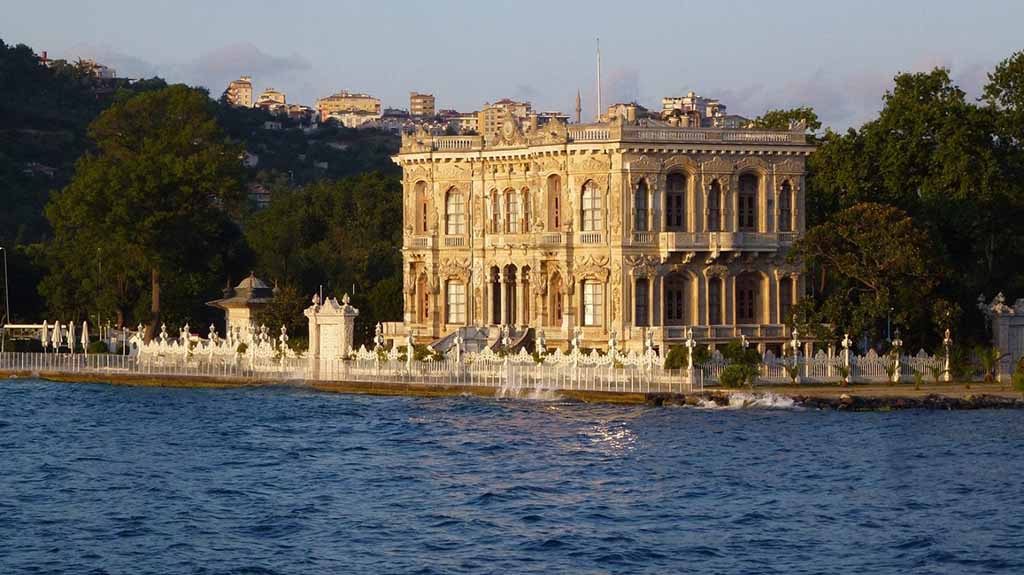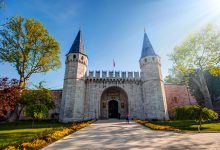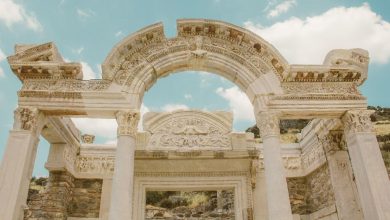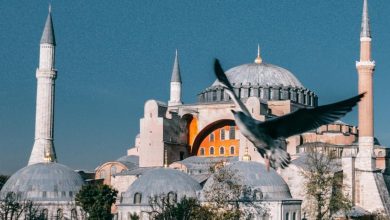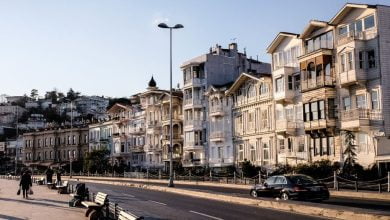Discover Palaces in Istanbul: Regal Wonders of the Past
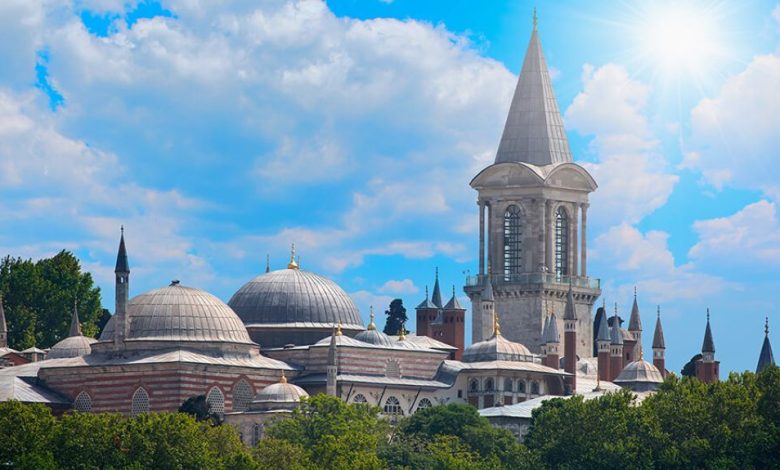
The beauty of Istanbul, the city of seven hills, has attracted the attention of monarchs, sultans, and kings since ancient times. For this reason, every civilization that settled here endeavoured to leave behind something of its cultural fabric. The most important examples of this can be seen in the magnificent palaces and courtyards which were built or restored during the Ottoman Empire. You should visit the palaces in Istanbul to travel back in time and leave behind the modern Istanbul skyline.
Contents
1. Topkapı Palace
Topkapi Palace, built by Fatih Sultan Mehmet, was the place where the Ottoman sultans lived and ruled, and where education took place. Built-in 1460 – 1478, with further parts, added later, this is where the sultanate treasury, Holy Relics and imperial archives are kept. There are various museums in the palace, including Hagia Eirene (where many concerts are held), the Department of Holy Relics and the Harem Department. There is an entrance fee for the museum and an extra fee to pay for entry to the Harem Department and Hagia Irene. No prams or pushchairs are allowed. Since the Holy Relics Department is of great religious importance, care should be taken not to enter wearing shorts, mini skirts, strappy blouses, and strapless tops. Topkapi Palace, which is closed on Tuesdays, is located in Sultanahmet, Fatih. Visit the website for detailed information. Further information is available here.
More Information
Open Hours: Winter Season 09:00 – 16:45, Summer Season 09: 00 – 18: 45 Closed on Tuesday
Location: View on Google Maps
Phone Number: (0212) 512 04 80
Website: millisaraylar.gov.tr
2. Beylerbeyi Palace
Beylerbeyi Palace, built by Sultan Abdülaziz between 1863 and 1865, was used by the Ottoman sultans as a summer residence. In later periods, it was registered to the imperial registers as the guest house where state guests were entertained. The palace consists of two separate sections called “Harem” and “Mabeyn”, making it similar to the old Ottoman houses. Built as a synthesis of the west and east, Beylerbeyi Palace has fantastic examples of baroque architectural details. It is located in Üsküdar. You can visit the website for detailed information about Beylerbeyi Palace which is closed on Mondays, and other information is available here.
More Information
Open Hours: 09:00 – 17:00 Closed on Mondays
Location: View on Google Maps
Phone Number: (0216) 321 93 20
Website: millisaraylar.gov.tr
3. Çırağan Palace
How about staying in historical accommodation in Istanbul? Ciragan Palace Kempinski Istanbul provides this opportunity. You can spend an enjoyable holiday staying in the suites of an Ottoman Palace, tasting Ottoman and Turkish dishes next to the Bosphorus, and swimming in the infinity pool with its stunning Bosphorus view. Between 1718 and 1730, known as the Tulip Era, the entertainment in candlelights was called “Çırağan”. The palace where this entertainment took place is called Çırağan. Çırağan Palace built by Grand Vizier Damat Ibrahim Pasha and his wife Fatima Sultan between Besiktas and Ortakoy was made of white marble. You can visit the website for detailed information.
More Information
Open Hours: 7/24
Location: View on Google Maps
Phone Number: (0212) 326 46 46
Website: kempinski.com
4. Yıldız Palace
Yıldız Palace is a grove that has survived the Byzantine Empire. After the conquest of Istanbul, in the grove that was renamed “Kazancı Garden”, Selim the Third built a mansion called “Yıldız” for his mother, Mihrişah Valide Sultan. Each of the sultans added a summer palace and a pavilion, and the Yıldız Palace was thus revealed. The pavilion, which is a part of Yıldız Palace and named “Yıldız Şale” originating from the French word “chalet”, is one of the most interesting structures of Ottoman architectural art. Apart from the traditional Ottoman housing structure, there are no “haremlik” (a part of the palace reserved for women) and “selamlık” (a part of the palace reserved for men) in Yıldız Palace. While visiting the building, be sure to visit the ceremony hall. Here you’ll be captivated by the Hereke carpet of 406 m² from wall to wall and the splendour of the gold-plated ceilings. Yıldız Palace is closed on Mondays and is open between 09.00 – 17:00 on other days. You can visit the website for detailed information or find it here.
More Information
Open Hours: Museum is closed to visitors due to restoration.
Location: View on Google Maps
Phone Number: (0212) 258 30 80
Website: millisaraylar.gov.tr
5. Küçüksu Pavilion
The history of the region where the Küçüksu Pavilion, which was built during the reign of Sultan Mahmut The First and completed in 1857, dates back to the Byzantine Empire. There are fireplaces made by various artists in each room of Küçüksu Pavilion, which sultans used for activities such as resting and entertaining. It is an art museum with European-style decorations, carpets, and paintings. Küçüksu Pavilion, which reflects the traditional Turkish style, is located on the Bosphorus between Küçüksu and Göksu Rivers. The Küçüksu Pavilion is closed on Mondays and is open from 09.00 to 17.00 on other days. There are also various restaurants and cafeterias in the area. You can visit the website for detailed information. You can find other pieces of information here.
More Information
Open Hours: 09:00 – 17:00 Closed on Mondays
Location: View on Google Maps
Phone Number: (0216) 332 33 03
Website: millisaraylar.gov.tr
6. Dolmabahçe Palace
The Dolmabahçe Palace, built by the thirteenth Ottoman Sultan, Sultan Abdülmecid between 1843 and 1856, consists of three main sections; Selamlık, Ceremonial Hall and Harem. Selamlık is the place where state affairs were conducted; the Ceremonial Hall is where the sultans gathered with the prominent figures of the state, and the harem was a special area where the sultan spent time with his family. Western architectural influences are seen in the details and the general structure of the palace which boasts 285 rooms, 43 halls, 68 toilets, and 6 baths. Selamlık, from where state affairs were conducted, is the most important part of the palace. Dolmabahçe Palace, where you can see the historical splendour of the Empire with all its details, is a palace you must see when you come to Istanbul. The palace is closed on Mondays and on all other days is open from 09.00 to 17.00. For more information please visit the website. You can find other pieces of information here.
More Information
Open Hours: 09:00 – 16:00 Closed on Mondays
Location: View on Google Maps
Phone Number: (0212) 236 90 00
Website: millisaraylar.gov.tr
7. Ihlamur Pavilion
Ihlamur Pavilion, located between Beşiktaş, Yıldız, and Nişantaşı, belonged to Hacı Hüseyin Ağa in the 18th century and was known as “Hacı Hüseyin Vineyards”. During the reign of Sultan Ahmet the Third, these vineyards were turned into “Hasbahçe”. When Sultan Abdülmecid inherited the throne in the 19th century, the building of the Ihlamur Pavilion began. The main building, the ceremony house, is particularly striking. The baroque-style staircase has a stunning design with interesting and vibrant reliefs. The ceremony house is open to visitors as a museum and palace. The “Maiyet Pavilion” on the other side is decorated with more modest decoration. The Maiyet Pavilion, a traditional-style building, includes a structure serving as the winter cafeteria. Cafeteria services are also available in the garden of the pavilion. Here you can sit and drink your coffee amongst the beauty of the mansion and garden. The Ihlamur Pavilion, which is closed on Mondays, is open from 09.00 to 17.00 on other days. For more information please visit the website. You can find other pieces of information here.
More Information
Open Hours: 09:00 – 17:00 Closed on Mondays and Thursdays
Location: View on Google Maps
Phone Number: (0212) 259 50 86
Website: millisaraylar.gov.tr
8. Hidiv Pavilion
The Hidiv Pavilion, built-in 1907, is located in the Çubuklu region of Beykoz. It was built by Abbas Hilmi Pasha, the last Ottoman governor of Egypt. Afterwards, a magnificent tower with a view of the Bosphorus was built along with the mansion, which was restored in accordance with the art nouveau style. Abbas Hilmi Pasha, who ended his duty as the Ottoman Governor after the British occupation of Egypt, was reportedly deported to Switzerland, but his family remained in the Hidiv Pavilion until 1937 when it was sold to the Istanbul Metropolitan Municipality. In the Hidiv Pavilion, which is open at all hours of the day, wedding ceremonies and various meetings take place. For more information, please visit the Turkish website. You can find other pieces of information here.
More Information
Open Hour: 09:00 – 23:00
Location: View on Google Maps
Phone Number: (0216) 413 92 53
9. Gülhane Park
This park was first used as an education grounds at 8. Century, by Byzantium. After being taken by Ottomans, these grounds were used as the outer garden of Topkapi Palace. One of the oldest places in Istanbul, this park deserves a visit. From a historical perspective, this park even has a column made by Romans. It has been used by Byzantium and Ottoman rulers, and from near history It households the first Ataturk statue. And because of its location, you can visit it between locations. It’s between the Topkapı Palace, Sarayburnu and Procession Kiosk (Alay Köşkü).
More Information
Location: View on Google Maps
10. Tekfur Palace
This is the place where the Kaşıkçı Diamond was found. This historical building has no known origin and is the first empire-building conquered by Ottomans, by taking over Istanbul. It is considered to be in use since 12. Century. And also, it is the only palace building left from the Byzantium era. Right now, it can be accessed as it opened for a visit to Çini Museum. You might want to visit this oldest palace in Istanbul.
More Information
Location: View on Google Maps
11. Galata Tower
This tower was built in 528 A.C. Originally made to help sailors and made from wood. Being a wooden tower is a fascinating fact, with looking at its history. Galata Tower survived for nearly 700 years without any major damage. In the year 1204, it was damaged by a fire and left damaged for over one hundred years. Around 1350, it was restored with stones, and today, it still stands strong. Over the years this tower was used as a beacon for sailors, a fire observation tower, a prison, and an observatory. Right now, it has a restaurant at the top where you can watch the city view without any obstacles. This tower is also the landmark of the story of Hezarfen Çelebi.
According to the story, Hezarfen Çelebi made wings by taking a model of eagle wings. Then he practised with these wings a few times and was convinced he can use them to fly long distances. Then he climbed the top of the Galata Tower. By using his eagle wings, he glided all the way to Üsküdar and landed with no significant damage. The era’s Sultan Murad Khan witnessed this event from Sarayburnu and summoned him to his presence. Sultan gave a sack of coins to Hezarfen Çelebi and said ‘This is a scary man. He is capable of doing anything he wants. It is not wise to keep such people around.’ and sent him to exile. After this ironic decree, Hezarfen Çelebi lived and died in exile. And another myth about Galata Tower is, whoever you climb the top of the tower with, is also the one who you will marry.
More Information
Location: View on Google Maps
Website: galatakulesi.org
12. Basilica Cistern
Basilica Cistern contains 336 pillars, which is the biggest cistern in Istanbul. With two Medusa heads at the base of two pillars, you can realize in its restoration Greek statues were used. Basilica Cistern frequently hosts artistic events and you should definitely visit if you come across it. It was built in the sixth century, by the order of the ruling Byzantium emperor for the purpose of providing freshwater to the great palace mainly. During the Ottoman reign, it was constantly restored and used for fresh water to the houses around. In 1987 it was publicly opened for a visit and considered as a historical landmark of Istanbul.
More Information
Location: View on Google Maps
Phone Number: (0212) 522 12 59
Website: yerebatansarnici.com




